The Sparidae family of the Perciformes order comprises about 160 fish species of 38 genera.
The fish of the family have mainly a broad body and a small mouth with teeth resembling molars of mammals. Some species have front teeth, the shape of which resembles incisors or fangs.
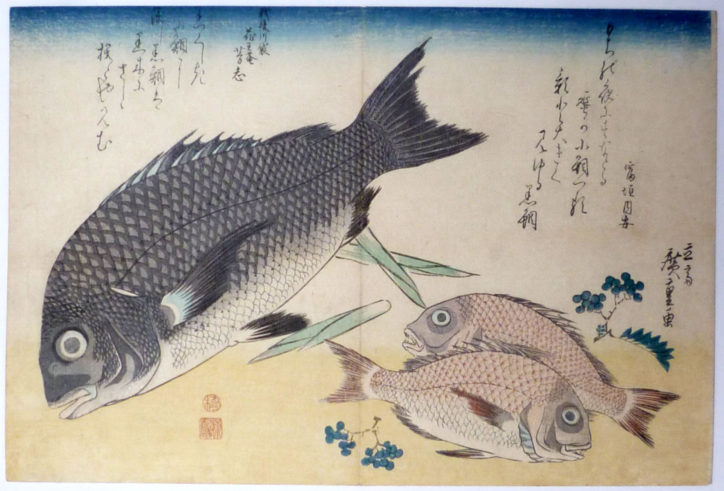
(Blackhead seabream (Acanthopagrus schlegelii) and yellowback seabream (Dentex tumifrons) together with bamboo shoots and Japanese pepper. Utagawa Hiroshige. 1832-1833. japaneseprints-london.com)
Many representatives of sea breams are of impressive size, red steenbras (Petrus rupestris) is the largest. It inhabits the southeastern Atlantic Ocean off the coast of South Africa, can be two meters long and weigh 80 kilograms.
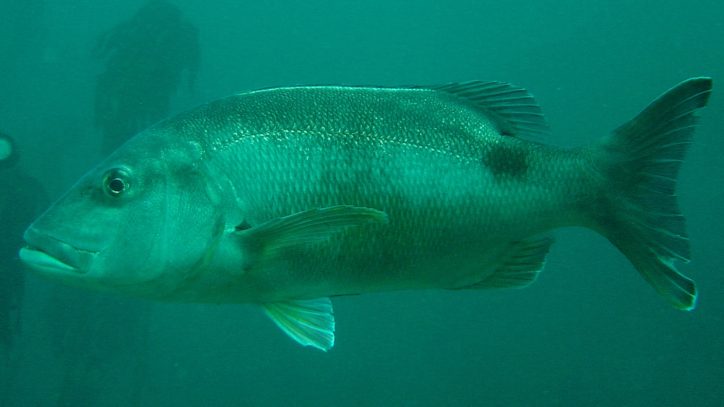
(Red steenbras. Photo by © Peter Southwood. en.wikipedia.org)
Many species of the Sparidae family look very much like predatory fish of another family of the Perciformes order – Lutjanidae (snappers). It inhabits the coastal tropical and subtropical waters of the Atlantic Ocean and the Indo-Pacific region.
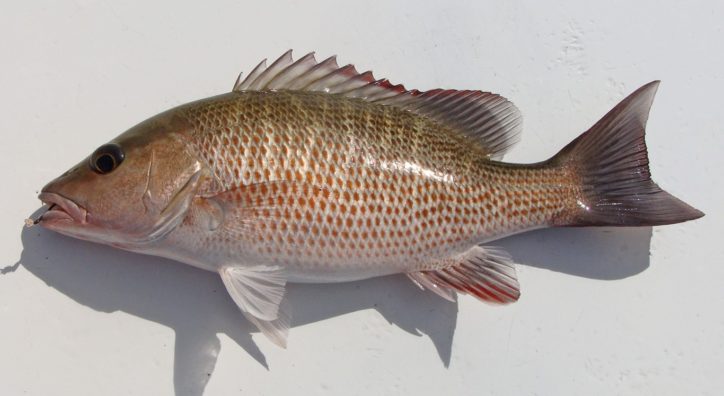
(Grey snapper (Lutjanus griseus). Photo by © Tom Berg. wildindiana.com)
Some local names of the fish are even more confusing. For example, Pagrus auratus inhabits the coastal waters of the Indo-Pacific region and is officially called silver seabream. It is also called Australasian snapper. Besides, they call it either pink snapper or simply snapper in New Zealand and Australia.
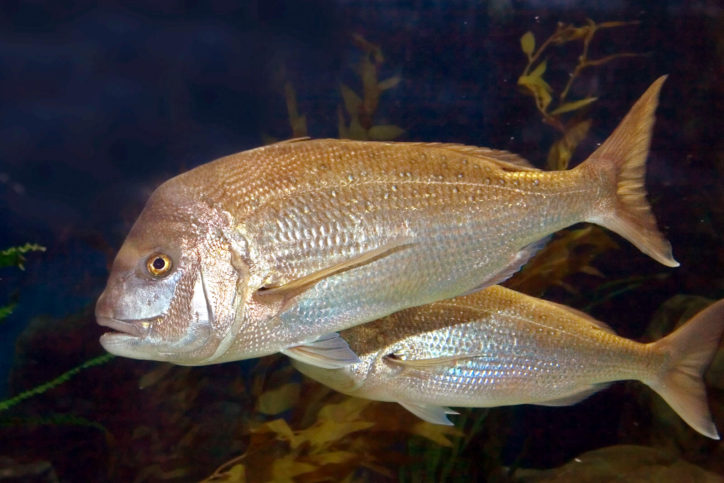
(Silver seabream. Photo by © Fir0002 / Flagstaffotos. en.wikipedia.org)
Despite the external resemblance, Lutjanidae, snappers, and Sparidae, sea breams or porgies are two different families of the Percoidea superfamily of the Perciformes order.
22 representatives of the Sparidae family of 12 genera are found in the Adriatic Sea.
The fish of the Boops genus are characterized by a rather small and short body with longitudinal golden stripes, as well as small teeth. One of two species of Boops is found in the Adriatic:
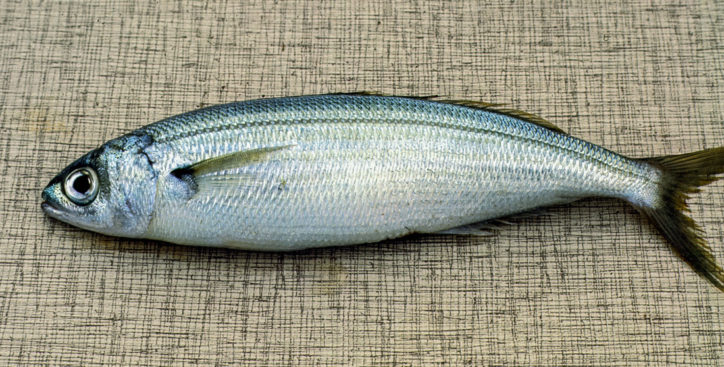
(Bogue. Photo © greekwildlife.gr)
It inhabits the depths of up to 350 meters, usually – up to 100 meters. It is a schooling species. The maximum recorded length is 40.2 cm, specimens up to 20 cm long are more common. The maximum weight is 990 grams. It prefers to swim close to the sandy, oozy, rocky and algae-covered bottom. It feeds mainly on crustaceans. It is a permanent inhabitant of the Adriatic Sea.
Sarpa salpa (the only representative of the Sarpa genus) used to be included in Boops. This fish became widely known after some articles had been published in the mid-2000s. The articles revealed the story about two visitors of the Mediterranean restaurant, who ate the meal made of Sarpa salpa flesh and had auditory and visual hallucinations, which began in 2 hours and lasted about 36 hours. It is considered that Sarpa salpa feeds on certain types of algae, which are digested and get into the tissues of the fish body. This may have the similar effect to the one described above.

(Salema. Photo © sepesca.com)
It inhabits the depth of 5-70 meters. It prefers to swim close to the rocky and sandy bottom, covered with aquatic vegetation. It is a schooling species. The maximum recorded length is 51 cm, specimens up to 30 cm long are more common. It feeds mainly on algae. It is a permanent inhabitant of the Adriatic Sea.
The Diplodus genus comprises 23 fish species of relatively small size, the length of the fish ranges from 20 to 60 centimeters. 4 representatives of the genus are found in the Adriatic Sea:
Annular seabream (Diplodus annularis).
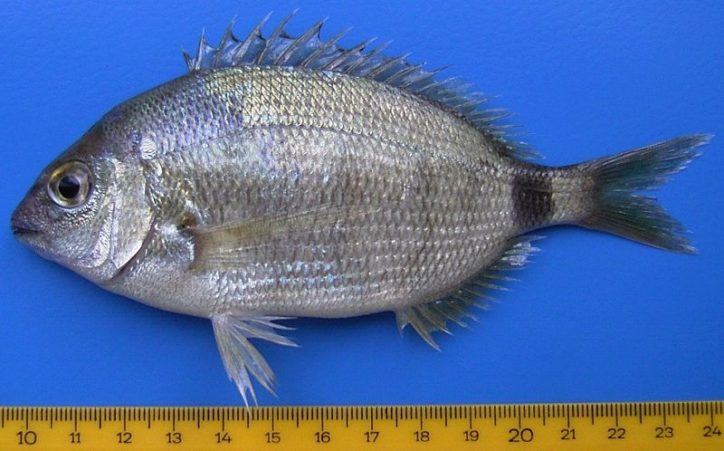
(Annular seabream. Photo © gafrd.org)
It inhabits the depths of up to 90 meters. It prefers to swim close to thickets of eelgrass or sea grass, in the fields of Posidonia, close to the sandy, less often – rocky bottom. The maximum recorded length is 24 cm, specimens up to 13 cm long are more common. It feeds mainly on worms, crustaceans, mollusks, echinoderms and jellyfishes. It is a permanent inhabitant of the Adriatic Sea.
Sharpsnout seabream (Diplodus puntazzo).

(Sharpsnout seabream. Photo by © lagunaproject.it)
It inhabits the depths of up to 150 meters, usually – up to 60 meters. It prefers to swim close to the rocky and sandy bottom. It is a schooling species. The maximum recorded length is 60 cm, specimens up to 30 cm long are more common. The maximum weight is 1.7 kilograms. It feeds mainly on algae, shellfishes, worms and shrimps. It is a permanent inhabitant of the Adriatic Sea.
White seabream (Diplodus sargus sargus).
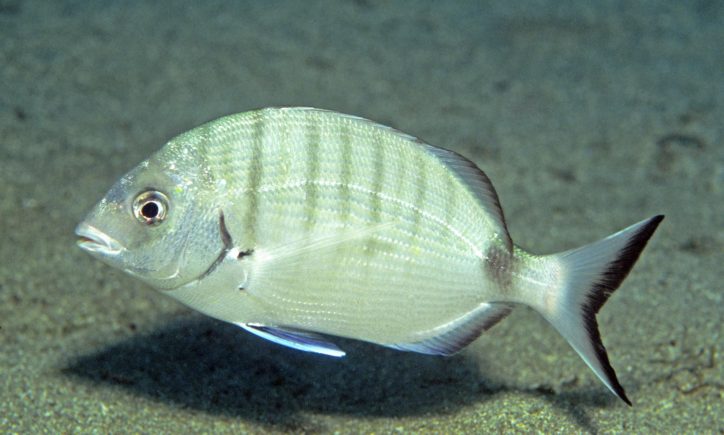
(White seabream. Photo by © Robert Patzner. iucnredlist.org)
It inhabits the depths of up to 50 meters. It prefers to swim in the coastal zone close to the rocky bottom and thickets of Posidonia. It often swims to the inshore at dawn. The maximum recorded length is 45 cm; specimens up to 22 cm are more common. The maximum weight is 1.9 kg. It feeds on small fish, mollusks, and other sediment dwellers. It is a permanent inhabitant of the Adriatic Sea.
Common two–banded seabream (Diplodus vulgaris).

(Common two-banded seabream. Photo © turkishseafoods.wordpress.com)
It inhabits the depths up to 160 meters, usually – up to 30 meters. It prefers to swim close to the rocky and sandy bottom, less often – among thickets of grass. The maximum recorded length is 45 cm, specimens up to 22 cm long are more common. The maximum weight is 1.3 kilograms. It feeds on crustaceans, worms and mollusks. It is a permanent inhabitant of the Adriatic Sea.
Fishes of the Spondyliosoma genus have an oval body, they are characterized by dichogamy – females can become males. The genus comprises two species, one of them is found in the Adriatic Sea.
Black seabream (Spondyliosoma cantharus).
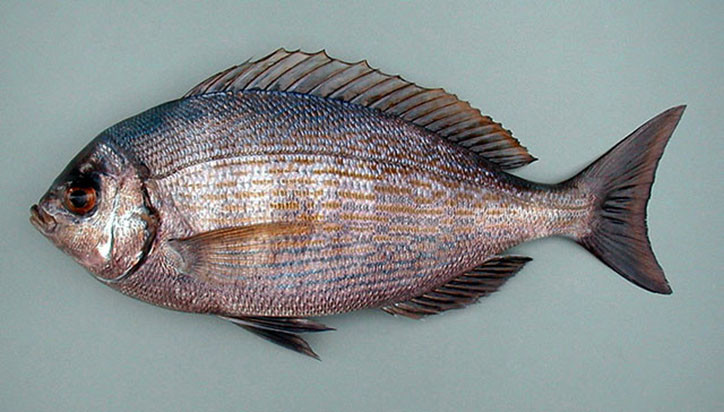
(Black seabream. Photo by © Pedro Niny Duarte(c)ImagDOP. fishbase.org)
It inhabits the depth of 5-300 meters. It prefers to swim close to the rocky and sandy bottom covered with sea grass. It is a schooling species. The maximum recorded length is 60 cm, specimens up to 30 cm long are more common. The maximum weight is 2.5 kilograms. It feeds on algae and small invertebrates, mainly crustaceans. It is a permanent inhabitant of the Adriatic Sea.
The Lithognathus genus comprises 4 fish species, 3 of which inhabit the areas near the coast of South Africa, and some of the latter ones are of a rather impressive size. For example, Lithognathus lithognathus can be up to two meters long. The only species found in the Adriatic Sea is smaller.
Sand steenbras (Lithognathus mormyrus).
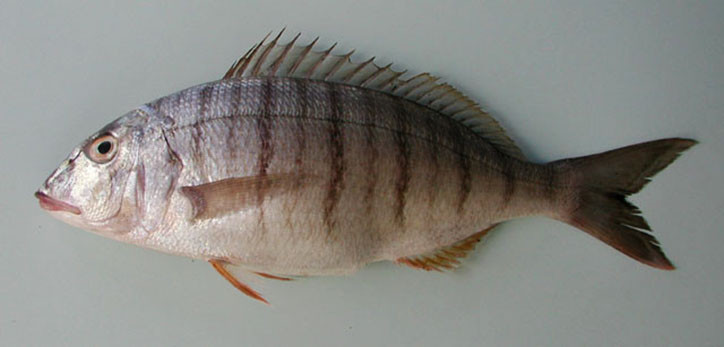
(Sand steenbras. Photo by © Rui Patricio Freitas. fishbase.org)
It inhabits the depths of up to 150 meters, usually – 10-20 meters. It prefers to swim close to the sandy and oozy bottom, as well as in thickets of algae and sea grass. It is a schooling species. The maximum recorded length is 55 cm, specimens up to 30 cm long are more common. The maximum weight is about 1 kilogram. It feeds on worms, mollusks and small crustaceans. It is a permanent inhabitant of the Adriatic Sea.
The Oblada genus comprises the only species inhabiting the Adriatic:
Saddled seabream (Oblada melanura).

(Saddled seabream. Photo by © Javier Vidal. flickr.com/photos/jarvidlop)
It inhabits the depths up to 30 meters. It prefers to swim close to the rocky and stony bottom, as well as the bottom covered with sea grass. It is a schooling species. The maximum recorded length is 36 cm, specimens up to 20 cm long are more common. The maximum weight is about 1 kilogram. It feeds on various invertebrates and small fish. It is a permanent inhabitant of the Adriatic Sea.
The Pagellus genus comprises 6 fish species that inhabit the basins of the Indian and Atlantic Oceans. They have a rather broad and laterally flattened body, which is typical of most representatives of the Sparidae family. Most often, they inhabit areas above the sandy and oozy bottom. They are protandric hermaphrodites – juveniles are males, and older fish turn into females, but this ability doesn’t manifest in all fish. 3 representatives of the genus are found in the Adriatic Sea:
Axillary seabream (Pagellus acarne).

(Axillary seabream. Photo by © Fabio Crocetta. naturamediterraneo.com)
It inhabits the depths of up to 500 meters, usually – 40-100 meters. It prefers to swim close to the sandy and algae-covered bottom. It is a schooling species. The maximum recorded length is 36 cm; specimens up to 25 cm long are more common. It feeds on worms, mollusks and crustaceans. It is a rather rare inhabitant of the Adriatic, which is more often found closer to the Ionian Sea.
Blackspot seabream (Pagellus bogaraveo).
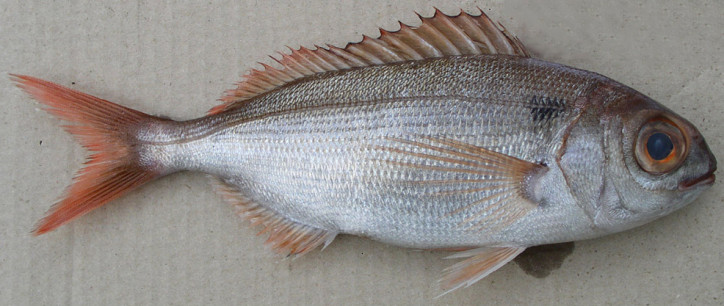
(Blackspot seabream. Photo by © S. Iglesias, Muséum national d’Histoire naturelle. mnhn.fr)
It inhabits the depths of up to 700 meters, usually – 150-300 meters. It prefers to swim close to the sandy, rocky and oozy bottom. It is a schooling species. The maximum recorded length is 70 cm, specimens up to 30 cm long are more common. The maximum weight is 4 kilograms. It feeds on crustaceans, mollusks, worms and small fish. It is a permanent inhabitant of the Adriatic Sea, which is more often found in its southern part.
Common pandora (Pagellus erythrinus).

(Common pandora. Photo by © Fabio Crocetta. naturamediterraneo.com)
It inhabits the depths of up to 300 meters, usually – 20-100 meters. It prefers to swim close to the rocky, pebble, oozy and sandy bottom. It is a schooling species. The maximum recorded length is 60 cm, specimens up to 25 cm long are more common. The maximum weight is 3.2 kilograms. It feeds on invertebrates and small fish. It is a permanent inhabitant of the Adriatic Sea.
The Dentex genus comprises 14 fish species. One row of conical shaped teeth, in which the front teeth are much larger than the others and resemble fangs, is a peculiar feature of dentexes. The fishes of the genus are predators that feed on fish, large mollusks and crustaceans. They inhabit the depths of up to 500 meters. But usually they don’t swim deeper than 100 m. 3 representatives of dentexes, which are the largest fish of the genus, are found In the Adriatic Sea.
Common dentex (Dentex dentex).
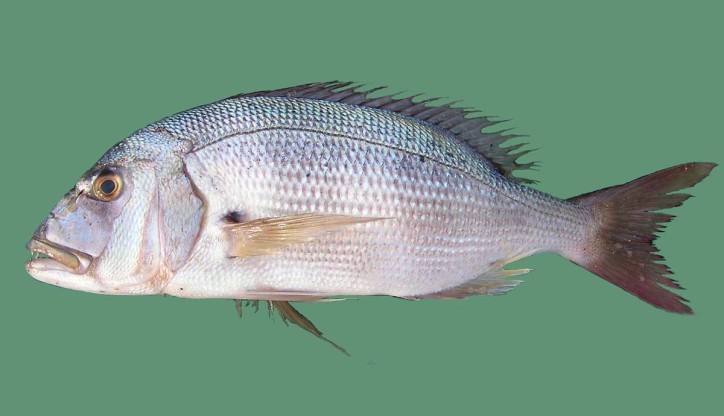
(Common dentex. Photo by © Jiří Novák. biolib.cz)
It inhabits the depths of up to 200 meters, usually – 15-50 meters. It prefers to swim close to the rocky and pebble bottom. The maximum recorded length is 100 cm, specimens up to 50 cm long are more common. The maximum weight is 14.3 kilograms. It feeds mainly on fish, gastropods and cephalopods. Large specimens are solitary predators. It is a permanent inhabitant of the Adriatic Sea.
Pink dentex (Dentex gibbosus).
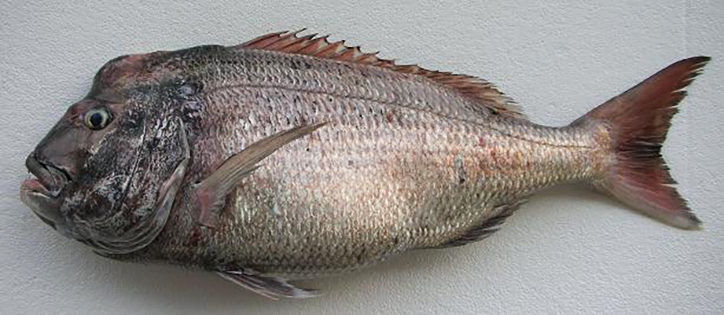
(Pink dentex. Foto © armacao.exblog.jp)
It inhabits the depth of 20-220 meters. It prefers to swim close to the rocky and pebble bottom, as well as near the sandy bottom near rocks. The maximum recorded length is 106 cm, specimens up to 60 cm long are more common. The maximum weight is 15 kilograms. It feeds on crustaceans, fish and cephalopods. Juveniles have very elongated third and fourth rays of the dorsal fin, which look like long threads. Specimens longer than 60-65 centimeters don’t have these threads. A large bulge appears on the forehead of large adult males over time.

(Pink dentex, juveniles. Foto © armacao.exblog.jp)
It is a permanent inhabitant of the Adriatic Sea.
Large–eye dentex (Dentex macrophthalmus).

(Large-eye dentex. Photo by © Pedro Niny Duarte(c)ImagDOP. fishbase.org)
It inhabits the depth of 30-500 meters. It prefers to swim close to the rocky and sandy bottom. The maximum recorded length is 65 cm, specimens up to 30 cm long are more common. It feeds on fish and crustaceans. It is a permanent rare inhabitant of the Adriatic Sea.
The Pagrus genus comprises 6 fish species, 3 of which are found in the Adriatic Sea.
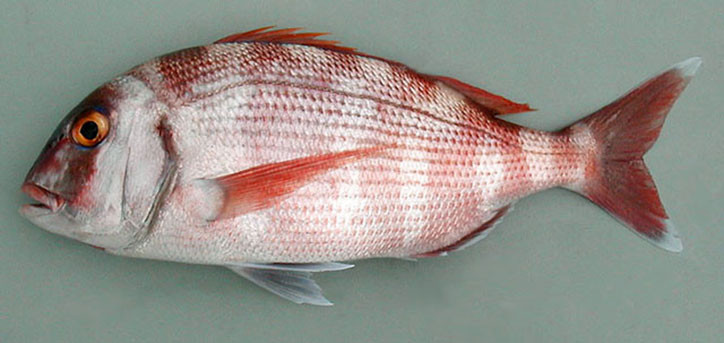
(Red porgy. Photo by © Pedro Niny Duarte(c)ImagDOP. fishbase.org)
It inhabits the depths of up to 250 meters, usually – 10-100 meters. It prefers to swim close to the rocky, pebble and sandy bottom. Juveniles prefer to swim close to the bottom covered with sea grass. The maximum recorded length is 91 cm, specimens up to 35 cm long are more common. The maximum weight is about 10 kilograms. It feeds on crustaceans, fish and mollusks. It is a permanent inhabitant of the Adriatic Sea.
Bluespotted seabream (Pagrus caeruleostictus).
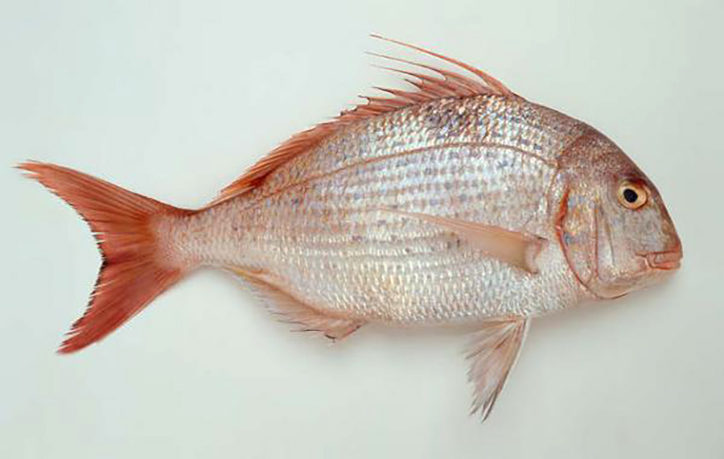
(Bluespotted seabream. Foto © pescanetwork.it)
It inhabits the depths of up to 200 meters. It prefers to swim close to the rocky and pebble bottom. The maximum recorded length is 90 cm, specimens up to 50 cm long are more common. The maximum weight is 11.6 kg. It feeds on bivalve mollusks, crustaceans and, less often, fish. It is a rare inhabitant of the Adriatic Sea, which is found only in its southern part.

(Red seabream. Photo by © Miya. en.wikipedia.org)
It inhabits the depth of 10-200 meters. The maximum recorded length is 100 cm, specimens up to 30 cm long are more common. The maximum weight is 9.7 kilograms. It feeds on echinoderms, worms, mollusks, crustaceans and fish. It is an introduced species in the Adriatic Sea. It was brought to Croatia for breeding in the 1990s from the Far East. The specimens, which were caught, were most likely to have escaped from the stocking ponds. Nowadays, it doesn’t occur in catches, since it probably didn’t adapt. Hybrids of the red porgies and other representatives of the Sparidae family are occasionally found near the peninsula of Istria (Croatia).
The Sparus genus comprises only one (but the most famous) representative of the family, that is, the gilthead bream. It is a protandric hermaphrodite, juveniles 1-2 years old (up to 20-30 cm long) are males, and older specimens turn into females. The popularity of the gilthead bream throughout the world was ensured by its successful artificial breeding and tastiness.
Gilthead seabream or gilt–head seabream (Sparus aurata).

(Gilthead seabream. Photo by © Poisson Flotté. flickr.com/photos/poissons-mediterranee)
It inhabits the depth of 1-150 meters, usually – 1-30 meters. It prefers to swim close to the sandy bottom covered with sea grass. The maximum recorded length is 70 cm, specimens up to 35 cm long are more common. According to some sources, the maximum weight is 17.2 kg (fishbase.org), but it is more likely that the fish, weighing more than 10 kilograms, are exceptions. It feeds mainly on mollusks. It is a permanent inhabitant of the Adriatic Sea.
The Centracanthus genus comprises only one species, inhabiting the Adriatic:
Curled picarel (Centracanthus cirrus).
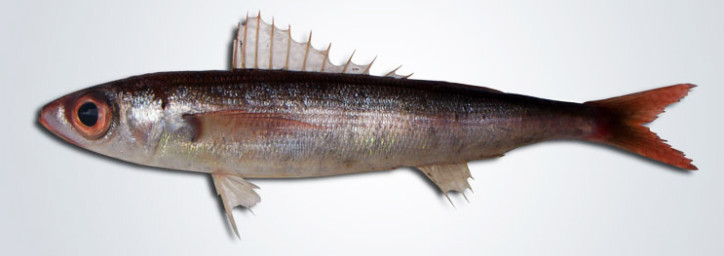
It inhabits the depth of up to 470 meters. It is a deep-water schooling species. It swims close to the coast for spawning in summer. It prefers to swim close to the rocky and pebble bottom. The maximum recorded length is 34 cm, specimens up to 12 cm long are more common. It feeds on zooplankton and small fish. It is an inhabitant of the southern part of the Adriatic Sea.
The Spicara genus comprises 8 species. Until 2014, picarels were considered to be the fish of a separate family. Spicara axillaris is the largest fish of the genus. It inhabits the southern coast of Africa. It can be up to 38 centimeters long. Two representatives of the genus are found in the Adriatic Sea:
Blotched picarel (Spicara maena).
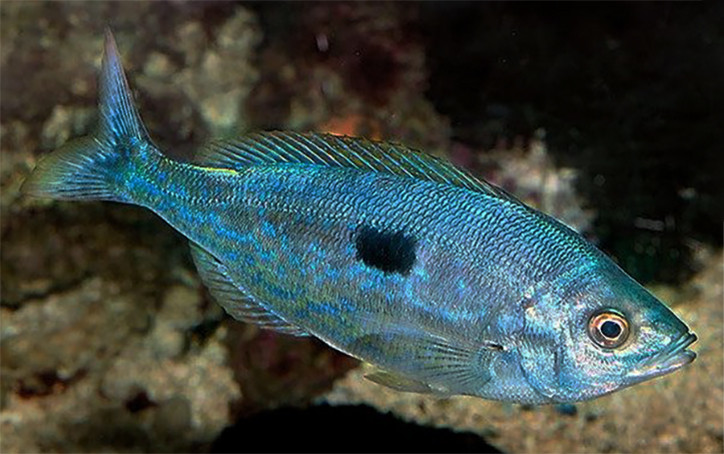
(Blotched picarel. Photo © coudouliere.fr)
It inhabits the depth of 30-130 meters. It is a pelagic coastal species. The maximum recorded length is 25 cm, specimens up to 14 cm long are more common. It feeds on zooplankton. It is a permanent inhabitant of the Adriatic Sea.
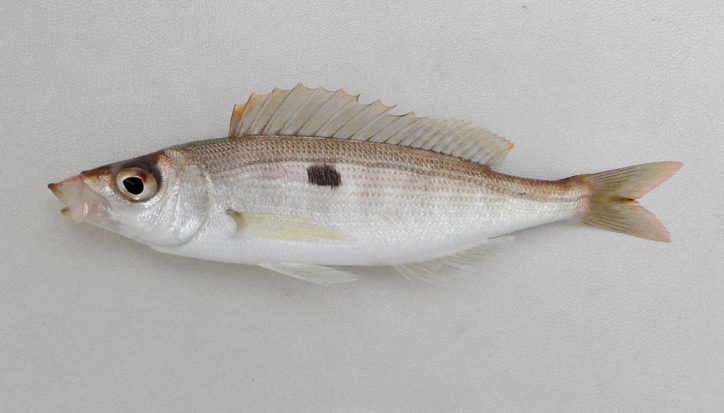
(Picarel. Photo by © Theo Modder. fishbase.org)
It inhabits the depth of 15-330 meters. Often, it prefers to swim close to the oozy bottom and fields of Posidonia. It is a pelagic schooling species. The maximum recorded length is 20 cm; specimens up to 14 cm long are more common. It feeds on zooplankton. It is a permanent inhabitant of the Adriatic Sea.